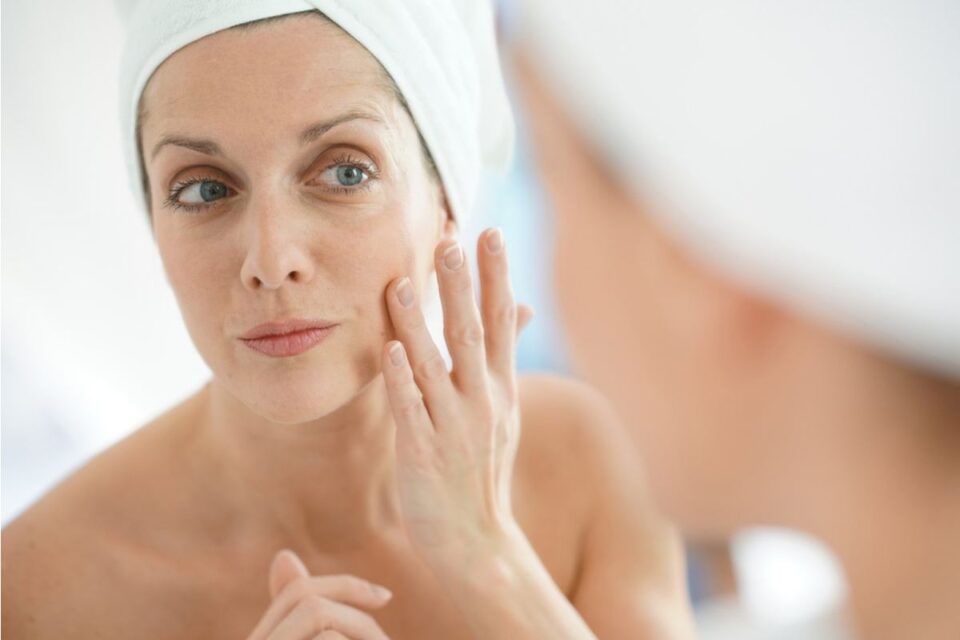Menopausal transition or perimenopause is the period during which your body begins to prepare for menopause. To mention a few, Hot flashes, brain fog, and a lack of libido are common symptoms of perimenopause, which are caused by low levels of the female sex hormone estrogen. But what effect does it have on your skin? As it turns out, quite a bit.
Table of Contents
Estrogen During Perimenopause
Estrogen has been linked to collagen creation, skin suppleness, thickness, and moisture levels, as well as healthy blood vessels. You may notice lines and wrinkles, dryness, sensitivity, dullness, and sagging if you make less estrogen.
Even professionals in the field of skin care, such as board-certified dermatologists, are affected by these changes. They, however, do not wait to act, and neither should you. Estrogen levels begin to drop during perimenopause, which can start as early as the mid-40s for some women and lasts four to ten years until menstruation stops. However, the fall is uneven, resulting in unpredictable skin behavior. It can feel like you’re half-teenager, with sporadic breakouts, and half-senior citizen, with excessive dryness, during this time.
Sporadic Breakouts With Excessive Dryness
Estrogen levels continue to fall until you reach menopause, which occurs when you haven’t had a period for at least 12 months. If this is the case, you are considered postmenopausal. Your skin problems may be more modest during perimenopause and more serious after menopause, but dermatologists treat them both similarly since they all affect the skin in the same way.
Effective Menopause Skincare Products
A moisturizing cream cleanser that won’t dry up your skin too much. dry skin might be better off with cream-based moisturizers. try vivier skin Canada cosmetics for the face and body to gain younger-looking results. With a rich occlusive moisturizer, you can restore your skin’s protective barrier.
When you’re having a bad case of hot flashes, reach for zo products with serum’s retinol ingredients. They effectively combat fine lines and sagging.
Plant extracts that plump the skin’s interior scaffolding. Plant oils offer your skin a healthy glow, while antioxidants protect it from damage.
There’s also a lot you can do at home to help soften and even reverse some of the skin changes that come with menopause. Here’s the lowdown:
Skin Dullness
Menopause-induced dryness, combined with slowed cell turnover owing to age, gives skin a dull appearance. This occurs when dead skin cells accumulate on the surface, creating hills and valleys. That doesn’t do a great job of reflecting light. Skin glows because of light reflection.
Exfoliate dead, dull skin to cure the problem. The importance of exfoliation in maintaining the appearance of glowing skin cannot be overstated. Alpha hydroxy acids (AHAs) can help slough off dead skin and expose a more youthful appearance. Glycolic acid, an AHA, is great since it is a humectant or moisture attractant. If your skin can handle it, use a glycolic-based serum every other day.
Dryness
Dryness indicates a problem with your skin’s outer protective barrier. The epidermis of the skin thickens as estrogen levels drop, limiting oil production. Skin gets drier, and microtears form, allowing moisture to exit and allergens to enter. As a result, skin becomes more readily irritated, and inflammatory skin diseases may become more prevalent.
Use a gentle cleanser that won’t strip dry skin of its natural oils (ideally a creamy cleanser, not a bubbly one). Then use a moisturizer that has components like ceramides, shea butter, fatty acids, squalene, glycerin, and hyaluronic acid to help preserve moisture in the skin’s barrier.
Acne
Even though your skin is becoming drier, you continue to break out. How is that possible? As estrogen levels fall, your female-to-male hormone ratio shifts—male hormone levels rise. Androgens, or male hormones, are one of the most common causes of pimples. Learn more about acne treatment vancouver.
Once again, retinol comes to the rescue. Pores stay clear and are less likely to clog and create a pimple because it increases cell turnover. You can also get rid of breakouts while softening wrinkles. If you’re having trouble with large pores you could try a gentle pore reduction treatment.
Sagging
Collagen, like its partner elastin, depletes with age, and elastin is what keeps skin taut. Elastin loss is particularly problematic for women of color throughout menopause. Because their skin pigment protects their collagen fibers from injury, their problem is skin fragility and sagging rather than lines and wrinkles.
Sunscreen and antioxidants (vitamins C, E, and Co-Q10, to mention a few) are vital for preventing sagging. Because estrogen protects against photoaging, avoiding sun damage becomes increasingly crucial as estrogen levels decline. Sagging is difficult to fix at home, unfortunately. Ultherapy, which employs ultrasound waves to tighten skin. Collagen shrinks when heated to a particular temperature, shortening the fibers and tightening the skin.
Wrinkles and Fine Lines
The diminishing collagen supply is at blame here. In your 30s, you begin to lose roughly 1% of your collagen per year, but this depletion significantly accelerates after menopause. In the first five years after menopause, you lose 30% of your collagen. As a result, it’s critical to continue building collagen while you still have the opportunity.
Topical retinoids (prescription or over-the-counter retinol serums) increase collagen formation and cell turnover, smoothing the skin. It is recommended to use a vitamin C serum on the skin and take an oral vitamin C supplement (500 mg twice a day). Collagen formation requires the antioxidant vitamin.


